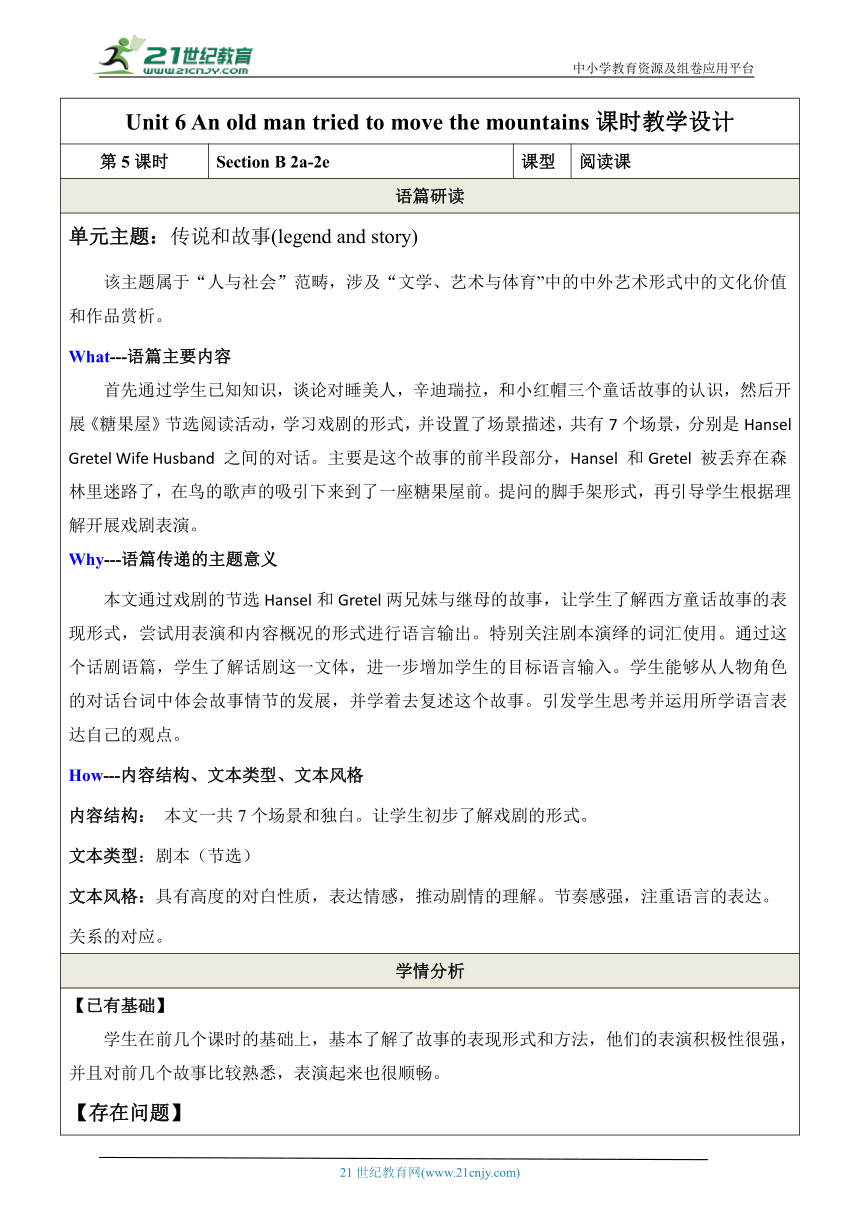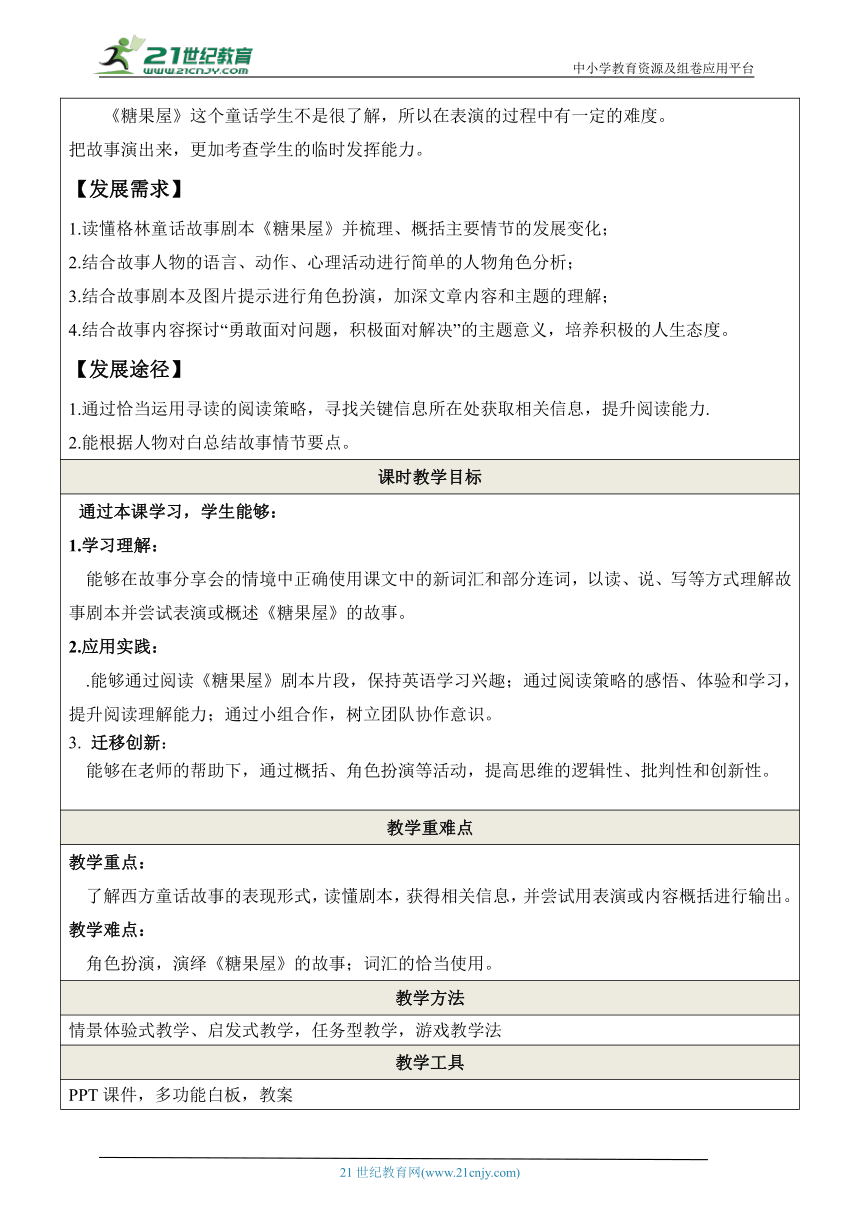Unit 6 Section B 2a-2e 表格式教学设计(人教版八年级下Unit 6 An old man tried to move the mountains)
文档属性
| 名称 | Unit 6 Section B 2a-2e 表格式教学设计(人教版八年级下Unit 6 An old man tried to move the mountains) |

|
|
| 格式 | docx | ||
| 文件大小 | 1.7MB | ||
| 资源类型 | 试卷 | ||
| 版本资源 | 人教新目标(Go for it)版 | ||
| 科目 | 英语 | ||
| 更新时间 | 2024-05-08 10:36:39 | ||
图片预览



文档简介
中小学教育资源及组卷应用平台
Unit 6 An old man tried to move the mountains课时教学设计
第5课时 Section B 2a-2e 课型 阅读课
语篇研读
单元主题:传说和故事(legend and story) 该主题属于“人与社会”范畴,涉及“文学、艺术与体育”中的中外艺术形式中的文化价值和作品赏析。 What---语篇主要内容 首先通过学生已知知识,谈论对睡美人,辛迪瑞拉,和小红帽三个童话故事的认识,然后开展《糖果屋》节选阅读活动,学习戏剧的形式,并设置了场景描述,共有7个场景,分别是Hansel Gretel Wife Husband 之间的对话。主要是这个故事的前半段部分,Hansel 和Gretel 被丢弃在森林里迷路了,在鸟的歌声的吸引下来到了一座糖果屋前。提问的脚手架形式,再引导学生根据理解开展戏剧表演。 Why---语篇传递的主题意义 本文通过戏剧的节选Hansel和 Gretel两兄妹与继母的故事,让学生了解西方童话故事的表现形式,尝试用表演和内容概况的形式进行语言输出。特别关注剧本演绎的词汇使用。通过这个话剧语篇,学生了解话剧这一文体,进一步增加学生的目标语言输入。学生能够从人物角色的对话台词中体会故事情节的发展,并学着去复述这个故事。引发学生思考并运用所学语言表达自己的观点。 How---内容结构、文本类型、文本风格 内容结构: 本文一共7个场景和独白。让学生初步了解戏剧的形式。 文本类型:剧本(节选) 文本风格:具有高度的对白性质,表达情感,推动剧情的理解。节奏感强,注重语言的表达。 关系的对应。
学情分析
【已有基础】 学生在前几个课时的基础上,基本了解了故事的表现形式和方法,他们的表演积极性很强,并且对前几个故事比较熟悉,表演起来也很顺畅。 【存在问题】 《糖果屋》这个童话学生不是很了解,所以在表演的过程中有一定的难度。 把故事演出来,更加考查学生的临时发挥能力。 【发展需求】 1.读懂格林童话故事剧本《糖果屋》并梳理、概括主要情节的发展变化; 2.结合故事人物的语言、动作、心理活动进行简单的人物角色分析; 3.结合故事剧本及图片提示进行角色扮演,加深文章内容和主题的理解; 4.结合故事内容探讨“勇敢面对问题,积极面对解决”的主题意义,培养积极的人生态度。 【发展途径】 1.通过恰当运用寻读的阅读策略,寻找关键信息所在处获取相关信息,提升阅读能力. 2.能根据人物对白总结故事情节要点。
课时教学目标
通过本课学习,学生能够: 1.学习理解: 能够在故事分享会的情境中正确使用课文中的新词汇和部分连词,以读、说、写等方式理解故事剧本并尝试表演或概述《糖果屋》的故事。 2.应用实践: .能够通过阅读《糖果屋》剧本片段,保持英语学习兴趣;通过阅读策略的感悟、体验和学习,提升阅读理解能力;通过小组合作,树立团队协作意识。 迁移创新: 能够在老师的帮助下,通过概括、角色扮演等活动,提高思维的逻辑性、批判性和创新性。
教学重难点
教学重点: 了解西方童话故事的表现形式,读懂剧本,获得相关信息,并尝试用表演或内容概括进行输出。 教学难点: 角色扮演,演绎《糖果屋》的故事;词汇的恰当使用。
教学方法
情景体验式教学、启发式教学,任务型教学,游戏教学法
教学工具
PPT课件,多功能白板,教案
教-学-评一体化教学过程
教学目标 教师活动 学生活动
Part1: 情景导入 1.Greeting. 2.T asks students to finish the task in 2a-- In the last lesson we learnt a famous western fairy tale called The Emperor’s New Clothes. Do you know other western fairy tales Have you ever read the following stories Can you say their English names T asks students to know about something about the fairy tales. 1完成书本2a任务。 2.了解童话故事
设计意图 利用课本任务导入,引出本课主题,引导学生思考并头脑风暴,在思考的过程中自然的感知目标语言,激发学生学习兴趣。
教学目标 学习活动 效果评价
Part 2: 学习理解 1.T asks students to Watch and answer the questions. 2.T asks students to Look at the picture and predict. 3.T asks students to Go through the passage and choose the correct answer. 4.T asks students to Try to find out the type of the text. 5.T asks students to Learn about the Reading Strategy. 观看视频并回答问题。 观察图片并预测。 阅读文本并选择。 分析文本类型。 了解文章背景知识。
设计意图 养成读前感知预测的好习惯。 通过读前预测任务活动激活旧知识,唤醒学生的记忆。
教学目标 教师活动 学生活动
Part 3: 应用实践 T asks students to Read the whole play and answer the questions. T asks students to finish the task in 2c--Match each description with the correct scene. T asks students to Try to find out the two conflicts. T asks students to Read Paragraph 1 and fill in the blanks. T asks students to Read scene 1-3,find out how do they save themselves. T asks students to Read scene 4-6, how about the second time T asks students to Read scene 7, fill in the blanks. T asks students to finish the task in 2d-- Read the play again and answer the questions. 扫读文章回答问题。 阅读文章匹配段落大意。 找出两个冲突场景。 阅读第一段并填空。 读1-3场景并填空。 读4-6场景并填空。 读7场景并填空。 完成书本2d任务。
设计意图 阅读策略:标题和图片可以帮助我们了解文章主题。 快速阅读,培养一种阅读技巧:从首句找出关键信息。 带着问题细读文章,目的性更强,有助于引导学生更好地理解文章意义。
教学目标 教师活动 学生活动
Part 4: 迁移创新 T asks students to Retell the story according to the mind map. T asks students to Try to write some key words from each scene. Then discuss your answers with your partner. T asks students to Then complete the summary of the play. T asks students to Think and Share:After reading the play, can you try to analyze the personality of the four people based on their lines and actions T asks students to finish the task in 2e-- Read the play with body language and facial expressions in groups of 4. 根据思维导图复述文章内容。 思考人物性格。 完成书本2e任务。
设计意图 回归课本练习,聚焦文展内容进行适当拓展练习,培养学生的思维能力。 小组合作探究培养学生的探索思维和发散思维,交际意识的提升更有助于素养的发展。
Part 5: 回顾总结 Summarize the key content in this lesson. 跟随老师一起进行内容总结。
设计意图 总结本课所学内容,巩固加深印象。 利用将思维导图给学生进行有序的梳理。
Part 6: 随堂小练 T assigns the test. 完成课堂练习。
课时教学板书设计
Unit 6 An old man tried to move the mountains. Section B 2a-2e Key words:stepmother, wife, husband, whole, scene, stone, shine, bright, as soon as,unless, so…that…. Key sentences:One year, the weather was so dry that no food would grow. As soon as you wake up,you must go to the forest with your father. We thought you were never coming back. It’s leading us to that wonderful house made of bread, cake and sugar. Who is brave enough to eat my house
评价量表
评价内容自评师评互评能够识别戏剧文体,掌握文章大意。能够理清事件发展顺序,提升关键词策略的运用能力。能够分析人物性格,提升批判性思维。
课时作业设计
作业内容 作业目标 设计意图
基础题: Read the rest part of the story. Then make a chart to analyze different characters in the story. 总结本课所学内容,巩固加深印象。 利用思维导图给学生进行有序的梳理。
提高题:Make some puppets of the characters in the story and try to act out the story with your friends. 将教学落到实处,交际意识培养之后,知识点的教授也跟上,保证学生在理解的同时能够运用到写作中去。 加深对本节课内容的理解和消化
课后反思(实施后填写)
本单元教材以“文学”为中心话题,围绕着“讲故事”进行学习和运用。设计该阅读课时,从greeting, lead-in,pre-reading,while-reading到post-reading的各个环节中充分考虑到学生的综合能力培养。该课时在快读、细读及细节理解上有优势,力求让学生既能完整地理解课文,也能就细节知识进行挖掘和推理。通过图片形式的视觉教学,提升学生的好奇心。在阅读中提问可以提高学生参与课堂的积极性。通过文章的学习和课堂练习,帮助学生掌握本课的关键词、短语和句型,进一步培养学生的综合阅读能力。通过分组表演,鼓励学生大胆词汇运用、自然发音以及动作配合,进一步巩固本课时的词汇和句型。
21世纪教育网 www.21cnjy.com 精品试卷·第 2 页 (共 2 页)
21世纪教育网(www.21cnjy.com)
Unit 6 An old man tried to move the mountains课时教学设计
第5课时 Section B 2a-2e 课型 阅读课
语篇研读
单元主题:传说和故事(legend and story) 该主题属于“人与社会”范畴,涉及“文学、艺术与体育”中的中外艺术形式中的文化价值和作品赏析。 What---语篇主要内容 首先通过学生已知知识,谈论对睡美人,辛迪瑞拉,和小红帽三个童话故事的认识,然后开展《糖果屋》节选阅读活动,学习戏剧的形式,并设置了场景描述,共有7个场景,分别是Hansel Gretel Wife Husband 之间的对话。主要是这个故事的前半段部分,Hansel 和Gretel 被丢弃在森林里迷路了,在鸟的歌声的吸引下来到了一座糖果屋前。提问的脚手架形式,再引导学生根据理解开展戏剧表演。 Why---语篇传递的主题意义 本文通过戏剧的节选Hansel和 Gretel两兄妹与继母的故事,让学生了解西方童话故事的表现形式,尝试用表演和内容概况的形式进行语言输出。特别关注剧本演绎的词汇使用。通过这个话剧语篇,学生了解话剧这一文体,进一步增加学生的目标语言输入。学生能够从人物角色的对话台词中体会故事情节的发展,并学着去复述这个故事。引发学生思考并运用所学语言表达自己的观点。 How---内容结构、文本类型、文本风格 内容结构: 本文一共7个场景和独白。让学生初步了解戏剧的形式。 文本类型:剧本(节选) 文本风格:具有高度的对白性质,表达情感,推动剧情的理解。节奏感强,注重语言的表达。 关系的对应。
学情分析
【已有基础】 学生在前几个课时的基础上,基本了解了故事的表现形式和方法,他们的表演积极性很强,并且对前几个故事比较熟悉,表演起来也很顺畅。 【存在问题】 《糖果屋》这个童话学生不是很了解,所以在表演的过程中有一定的难度。 把故事演出来,更加考查学生的临时发挥能力。 【发展需求】 1.读懂格林童话故事剧本《糖果屋》并梳理、概括主要情节的发展变化; 2.结合故事人物的语言、动作、心理活动进行简单的人物角色分析; 3.结合故事剧本及图片提示进行角色扮演,加深文章内容和主题的理解; 4.结合故事内容探讨“勇敢面对问题,积极面对解决”的主题意义,培养积极的人生态度。 【发展途径】 1.通过恰当运用寻读的阅读策略,寻找关键信息所在处获取相关信息,提升阅读能力. 2.能根据人物对白总结故事情节要点。
课时教学目标
通过本课学习,学生能够: 1.学习理解: 能够在故事分享会的情境中正确使用课文中的新词汇和部分连词,以读、说、写等方式理解故事剧本并尝试表演或概述《糖果屋》的故事。 2.应用实践: .能够通过阅读《糖果屋》剧本片段,保持英语学习兴趣;通过阅读策略的感悟、体验和学习,提升阅读理解能力;通过小组合作,树立团队协作意识。 迁移创新: 能够在老师的帮助下,通过概括、角色扮演等活动,提高思维的逻辑性、批判性和创新性。
教学重难点
教学重点: 了解西方童话故事的表现形式,读懂剧本,获得相关信息,并尝试用表演或内容概括进行输出。 教学难点: 角色扮演,演绎《糖果屋》的故事;词汇的恰当使用。
教学方法
情景体验式教学、启发式教学,任务型教学,游戏教学法
教学工具
PPT课件,多功能白板,教案
教-学-评一体化教学过程
教学目标 教师活动 学生活动
Part1: 情景导入 1.Greeting. 2.T asks students to finish the task in 2a-- In the last lesson we learnt a famous western fairy tale called The Emperor’s New Clothes. Do you know other western fairy tales Have you ever read the following stories Can you say their English names T asks students to know about something about the fairy tales. 1完成书本2a任务。 2.了解童话故事
设计意图 利用课本任务导入,引出本课主题,引导学生思考并头脑风暴,在思考的过程中自然的感知目标语言,激发学生学习兴趣。
教学目标 学习活动 效果评价
Part 2: 学习理解 1.T asks students to Watch and answer the questions. 2.T asks students to Look at the picture and predict. 3.T asks students to Go through the passage and choose the correct answer. 4.T asks students to Try to find out the type of the text. 5.T asks students to Learn about the Reading Strategy. 观看视频并回答问题。 观察图片并预测。 阅读文本并选择。 分析文本类型。 了解文章背景知识。
设计意图 养成读前感知预测的好习惯。 通过读前预测任务活动激活旧知识,唤醒学生的记忆。
教学目标 教师活动 学生活动
Part 3: 应用实践 T asks students to Read the whole play and answer the questions. T asks students to finish the task in 2c--Match each description with the correct scene. T asks students to Try to find out the two conflicts. T asks students to Read Paragraph 1 and fill in the blanks. T asks students to Read scene 1-3,find out how do they save themselves. T asks students to Read scene 4-6, how about the second time T asks students to Read scene 7, fill in the blanks. T asks students to finish the task in 2d-- Read the play again and answer the questions. 扫读文章回答问题。 阅读文章匹配段落大意。 找出两个冲突场景。 阅读第一段并填空。 读1-3场景并填空。 读4-6场景并填空。 读7场景并填空。 完成书本2d任务。
设计意图 阅读策略:标题和图片可以帮助我们了解文章主题。 快速阅读,培养一种阅读技巧:从首句找出关键信息。 带着问题细读文章,目的性更强,有助于引导学生更好地理解文章意义。
教学目标 教师活动 学生活动
Part 4: 迁移创新 T asks students to Retell the story according to the mind map. T asks students to Try to write some key words from each scene. Then discuss your answers with your partner. T asks students to Then complete the summary of the play. T asks students to Think and Share:After reading the play, can you try to analyze the personality of the four people based on their lines and actions T asks students to finish the task in 2e-- Read the play with body language and facial expressions in groups of 4. 根据思维导图复述文章内容。 思考人物性格。 完成书本2e任务。
设计意图 回归课本练习,聚焦文展内容进行适当拓展练习,培养学生的思维能力。 小组合作探究培养学生的探索思维和发散思维,交际意识的提升更有助于素养的发展。
Part 5: 回顾总结 Summarize the key content in this lesson. 跟随老师一起进行内容总结。
设计意图 总结本课所学内容,巩固加深印象。 利用将思维导图给学生进行有序的梳理。
Part 6: 随堂小练 T assigns the test. 完成课堂练习。
课时教学板书设计
Unit 6 An old man tried to move the mountains. Section B 2a-2e Key words:stepmother, wife, husband, whole, scene, stone, shine, bright, as soon as,unless, so…that…. Key sentences:One year, the weather was so dry that no food would grow. As soon as you wake up,you must go to the forest with your father. We thought you were never coming back. It’s leading us to that wonderful house made of bread, cake and sugar. Who is brave enough to eat my house
评价量表
评价内容自评师评互评能够识别戏剧文体,掌握文章大意。能够理清事件发展顺序,提升关键词策略的运用能力。能够分析人物性格,提升批判性思维。
课时作业设计
作业内容 作业目标 设计意图
基础题: Read the rest part of the story. Then make a chart to analyze different characters in the story. 总结本课所学内容,巩固加深印象。 利用思维导图给学生进行有序的梳理。
提高题:Make some puppets of the characters in the story and try to act out the story with your friends. 将教学落到实处,交际意识培养之后,知识点的教授也跟上,保证学生在理解的同时能够运用到写作中去。 加深对本节课内容的理解和消化
课后反思(实施后填写)
本单元教材以“文学”为中心话题,围绕着“讲故事”进行学习和运用。设计该阅读课时,从greeting, lead-in,pre-reading,while-reading到post-reading的各个环节中充分考虑到学生的综合能力培养。该课时在快读、细读及细节理解上有优势,力求让学生既能完整地理解课文,也能就细节知识进行挖掘和推理。通过图片形式的视觉教学,提升学生的好奇心。在阅读中提问可以提高学生参与课堂的积极性。通过文章的学习和课堂练习,帮助学生掌握本课的关键词、短语和句型,进一步培养学生的综合阅读能力。通过分组表演,鼓励学生大胆词汇运用、自然发音以及动作配合,进一步巩固本课时的词汇和句型。
21世纪教育网 www.21cnjy.com 精品试卷·第 2 页 (共 2 页)
21世纪教育网(www.21cnjy.com)
同课章节目录
- Unit 1 What's the matter?
- Section A
- Section B
- Unit 2 I'll help to clean up the city parks.
- Section A
- Section B
- Unit 3 Could you please clean your room?
- Section A
- Section B
- Unit 4 Why don't you talk to your parents?
- Section A
- Section B
- Unit 5 What were you doing when the rainstorm came
- Section A
- Section B
- Review of Units 1-5
- Unit 6 An old man tried to move the mountains.
- Section A
- Section B
- Unit 7 What's the highest mountain in the world?
- Section A
- Section B
- Unit 8 Have you read Treasure Island yet?
- Section A
- Section B
- Unit 9 Have you ever been to a museum?
- Section A
- Section B
- Unit 10 I've had this bike for three years.
- Section A
- Section B
